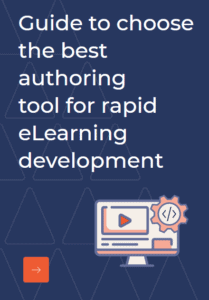eLearning is a vast field and often takes different shapes, sizes and forms. And when we say forms it includes various technologies too. Most of us are well aware that eLearning can be anything from small video snippets to fully designed courses to interactives to games and simulations too.
Most organizations however get started with eLearning without even taking the time to understand the basic difference between those. In this blog we would like to concentrate on simulations.
Wikipedia defines Simulation as, "the imitation of the operation of a real-world process or system over time. The act of simulating something first requires that a model be developed; this model represents the key characteristics or behaviors/functions of the selected physical or abstract system or process". In simpler terms it is a replication of some system or process in a controlled environment where the users can experiment and learn.
The next question that usually crosses one's mind is how to create a Simulation Based eLearning Course?
The process of creating a simulation-based eLearning is quite similar to that of any eLearning course; however there are some aspects that need particular attention too. Below are the 7 key steps to be followed:
- Identify the learning objective/goal - As with any eLearning course, it is essential to understand what outcomes or what learning is to be achieved using the simulation. For instance if you are to create a flight simulator the learning objective here would be gaining a clear understanding about the flight controls, few maneuvers etc.
- Research/Content Gathering - Once the learning objective is set, start collecting all the information required to create the simulation. It's an evident fact that in order to create a simulation well you have to be well versed with the system yourself or need the help of someone who is. During this stage you can also conclude on the type of software/platform on which the simulation can be created, or choose an authoring tool that has the necessary capabilities (not many authoring tools have the capability though).
- Model creation/Storyboarding – For any simulation to be created there ought to be proper planning. Based on the understanding of the system to be replicated, and the requirement gathering done, the instructional designers or SME's in some cases device a plan for presenting the process in the best way.
- Prototyping - This is a crucial step and its success affects the success of the entire project. The various parameters that constitute the simulation are tried and validated here, its functioning verified and shortcomings analyzed, followed by modification of the model accordingly.
- Actual Development - The actual simulation is created based on the prototype. This usually involves complex programming, based on the type of simulation being created.
- Testing - Once the simulation is created, it is essential to test it from all angles including functionalities, parameters, cross check with planned aspects, language and usability too. The errors are logged and corrections done followed by yet another testing until all bugs are removed.
- Deployment - The development process for any eLearning comes to an end with the deployment of the course on the platform/LMS of your choice, it is the same for simulations too.
Always remember that no eLearning is created without a basic level of experience and more so when it comes to creating Simulation Based course. In-house content creation in such cases can be highly risky unless you have the necessary manpower and expertise. Most organizations opt to outsource such complex projects to experienced eLearning vendors instead.
Hope this post provides better clarity about creation of simulation-based eLearning. Knowzies is known for its custom mobile learning solutions and mobile apps too. Feel free to contact us in case of any eLearning related queries. You can read more about How to create simulation based eLearning courses using Articulate Storyline.



